Issue 18. 17 November 2008 - UWA Staff - The University of Western ...
Issue 18. 17 November 2008 - UWA Staff - The University of Western ...
Issue 18. 17 November 2008 - UWA Staff - The University of Western ...
You also want an ePaper? Increase the reach of your titles
YUMPU automatically turns print PDFs into web optimized ePapers that Google loves.
Escape to France<br />
through words<br />
by Sally-Ann Jones<br />
What do you do as an Australian<br />
woman interested in women’s<br />
writing, who has had a long love<br />
affair with France, and who has<br />
an Honorary Fellowship in<br />
European Languages and<br />
Studies?<br />
If you’re Dr Rosemary Lancaster<br />
(pictured below), you write a book<br />
entitled Je Suis Australienne –<br />
Remarkable Women in France, 1880 –<br />
1945. Published by <strong>UWA</strong> Press, the<br />
book tells the stories <strong>of</strong> several diverse<br />
Australian women travellers.<br />
“<strong>The</strong>y’re heroic, individual and<br />
unusual. Some are bohemian. Some,<br />
like the nurses, were thrust by their<br />
vocation into an alien environment,”<br />
Dr Lancaster said. She added that the<br />
most time-consuming aspect <strong>of</strong><br />
preparing the book was fi nding<br />
women who were not only interesting<br />
enough, but who had written<br />
extensively enough for her to be able<br />
to mine their letters and diaries and, in<br />
some cases, their novels and and<br />
autobiographies.<br />
Much <strong>of</strong> the material was gathered<br />
from the Australian War Memorial and<br />
the National Library <strong>of</strong> Australia. And<br />
Dr Lancaster travelled to France and<br />
Britain to photograph some <strong>of</strong> the<br />
places where her women worked and<br />
trained. She was also able to<br />
illustrate her six chapters with a<br />
photo <strong>of</strong> a handwritten diary entry <strong>of</strong><br />
one <strong>of</strong> her subjects and the paintings<br />
<strong>of</strong> another.<br />
Sixteen year-old Daisy White, who<br />
travelled to a Parisian fi nishing school<br />
from her father’s New South Wales<br />
station in the 1880s, is the subject <strong>of</strong><br />
the fi rst chapter <strong>of</strong> the book which, in<br />
its chronological examination <strong>of</strong> the<br />
women’s lives, is also a record <strong>of</strong> the<br />
evolution <strong>of</strong> women’s travel.<br />
Daisy’s diaries, kept in the<br />
National Library had not<br />
been looked at for over<br />
a century until they<br />
were discovered in 2001<br />
by a French scholar.<br />
Dr Lancaster viewed<br />
the original manuscript<br />
and encountered a<br />
young woman who<br />
immersed herself in French<br />
poetry, literature and theatre only to<br />
die <strong>of</strong> fever in Brisbane at the age <strong>of</strong><br />
32. Dr Lancaster subsequently<br />
discovered that Daisy had become a<br />
medical doctor.<br />
A Tasmanian novelist, whose<br />
pseudonym was Tasma, and who<br />
worked as a journalist for “<strong>The</strong><br />
Australasian” newspaper is the focus<br />
<strong>of</strong> the next chapter. She was in Paris<br />
during the decadent Belle Epoque and<br />
wrote <strong>of</strong> the music halls when they<br />
were at their height. Eight nurses who<br />
cared for their patients in Somme<br />
military nursing stations and whose<br />
letters tell <strong>of</strong> their regard for their<br />
charges are the<br />
subject <strong>of</strong> the third chapter.<br />
Stella Bowen, an artist who became<br />
the <strong>of</strong>fi cial Australian artist <strong>of</strong> the<br />
Second World War, comes next.<br />
“Stella Bowen is the woman I like<br />
most,” Dr Lancaster said. “She<br />
suffered humiliation at the hands <strong>of</strong> her<br />
philandering lover, Ford Maddox Ford,<br />
had a daughter by him and was a<br />
good mother. She didn’t have much<br />
money but she did have a lot <strong>of</strong> grit.<br />
She was determined to be an artist,<br />
no matter what.”<br />
<strong>The</strong> novelist Christina Stead, who<br />
worked as a secretary for a troubled<br />
Paris bank after the Wall Street crash<br />
and who wrote about the bank as a<br />
metaphor for a Europe plagued by the<br />
rise <strong>of</strong> fascism, is the next chapter’s<br />
subject. <strong>The</strong> last is devoted to Nancy<br />
Wake, the Resistance fi ghter who<br />
trained as a secret agent.<br />
Dr Lancaster’s next project is a book<br />
about the poet Rene Char and his<br />
interactions with and responses to<br />
artists, from those who created<br />
prehistoric cave paintings to fi gures<br />
such as Picasso and Dali.<br />
And then she plans to write about<br />
women who visited the Riviera –<br />
women like Katherine Mansfi eld, the<br />
celebrity chefs <strong>of</strong> their day Elizabeth<br />
David and Julia Child, and the writers<br />
Collette and Francoise Sagan.<br />
<strong>The</strong> <strong>University</strong> <strong>of</strong> <strong>Western</strong> Australia <strong>UWA</strong> NEWS <strong>17</strong> <strong>November</strong> <strong>2008</strong> 11



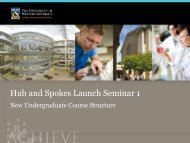

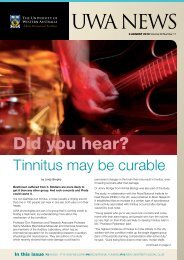






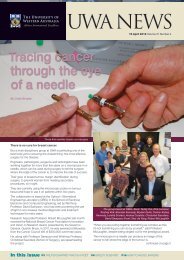
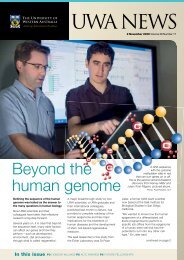
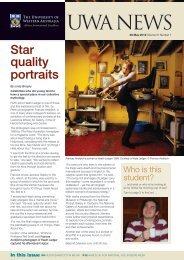

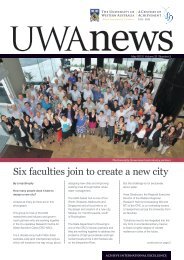
![Issue 13. 6 September 2010.pdf [PDF File, 1.7 MB] - UWA Staff - The ...](https://img.yumpu.com/26619782/1/184x260/issue-13-6-september-2010pdf-pdf-file-17-mb-uwa-staff-the-.jpg?quality=85)